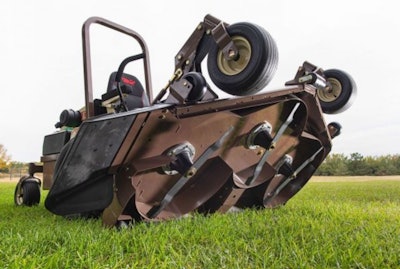
The health and appearance of your lawn can tell a story about your mower maintenance. If you notice dead, frazzled grass with split ends, that’s a sign that it’s time to sharpen blades. Don’t wait until the turf gives you a 911 signal to attend to routine mower maintenance.
Timing is everything
When is the best time to perform mower maintenance? That depends.
End-of-season mower maintenance allows you to manage important winterizing tasks and handle checkpoints like sharpening blades and changing the oil. As a result, you’re ready to mow in early spring without delay. However, depending on how often you’re mowing, you should monitor the blades, the oil level and the air filter throughout the season.
Preseason mower maintenance is also beneficial, providing a onceover after the mower has been in storage during winter. For example, if you haven’t used the mower for several months, you’ll want to reconnect or replace the spark plug, if necessary.
There’s no “perfect time” to perform routine mower maintenance. It should always be top of mind, so you can mow safely and achieve the quality of cut you expect. And there are some quick maintenance checks you should do before each time you mow.
10 Mower maintenance steps to prevent downtime
Regular maintenance isn’t complex and will keep your mower in optimal working order.
1. Check engine oil. Before starting the mower, check your oil and be sure to change it at regular intervals based on the owner’s manual. Remember to read and refer to this important document as it will also recommend the proper grade of oil.
2. Replace and clean the air filter. When an air filter is dirty, it restricts airflow to the engine. A simple maintenance task can prevent a chain reaction of events affecting your mower’s performance and longevity. While changing, use OEM filters.
3. Check the transmission fluid. Before every mowing, check the transmission fluid level. Much like oil, neglecting the transmission fluid causes it to break down and lose its ability to lubricate and clean, damaging internal components that can cause a system failure. Change the transmission fluid at recommended intervals based on your model’s owner’s manual.
4. Clear debris from the mower deck. It doesn’t take long to examine the engine, mower deck and other mower parts and free these areas of debris like grass clumps, sticks or mud. We suggest using compressed air to clean your mower after each use.
5. Sharpen blades often. Your mower’s blades will wear down over time, and if not maintained properly, they can harm your turf. Sharpen them at least every eight hours of use to prevent damage and protect your lawn.
6. Check the mower deck belt. Mower deck belts turn pulleys with the attached mower blades. When belts are compromised, cutting the grass feels more challenging. Excessive vibration, squealing and loss of power are signs that your mower deck belt may be failing. You can also feel a loss of power, since the blades aren’t turning at the optimum speed, leading to a rougher cut. Evaluate belt tension and make needed adjustments before every mowing. You should always use OEM belts. OEM belts require certain pulleys, tension and flexibility, which aren’t available on aftermarket belts.
7. Replace the spark plugs. Does your mower feel like it’s running rough and not quite catching when you want to start it? A specific amount of electricity from the spark plug is necessary to start the engine—and spark plugs aid in fuel combustion. Generally, you should replace the spark plug every 100 hours, but always verify the maintenance schedule in your owner’s manual.
8. Replace the fuel filter. The fuel filter is another critical part that cleans the fuel as it travels from the tank to the engine. It ensures that potential collected particles in your fuel storage container don’t pass through to the engine (which would compromise its efficiency and wear down parts over time).
9. Check the tire pressure. We know when our vehicles have a flat tire, and a handy tire pressure light warns us, but what about your mower? If tire pressure is off balance, you’ll get an uneven cut because the mower deck will sit lower on the side where a tire needs air.
Ergonomically speaking, proper tire pressure provides a smoother ride that is easier on your body. If you feel every bump and groove in the lawn, it’s a sign to check your tires. Overinflated tires can also cause a rough ride. Before mowing, check your mower’s manual for the appropriate air tire pressure and measure with a low-pressure tire gauge.
10. Remember the fuel stabilizer. You probably won’t need a fuel stabilizer during the mowing season because you’re regularly operating the equipment. However, if your mower sits for several weeks or longer, such as during the winter, you should add a fuel stabilizer to the tank. That way, you don’t need to drain the tank before storage, and your fuel will stay fresh for up to two years (refer to the label). Fuel stabilizer prevents buildup in the engine fuel system—a costly repair if you let it go.

![Gravely Pro Turn Mach One My23 Dsc03139 Edit 1200x800 5b2df79[1]](https://img.greenindustrypros.com/mindful/acbm/workspaces/default/uploads/2025/10/gravely-pro-turn-mach-one-my23-dsc03139-edit-1200x800-5b2df791.BucBnDoN22.jpg?auto=format%2Ccompress&fit=crop&h=100&q=70&w=100)







![Gravely Pro Turn Mach One My23 Dsc03139 Edit 1200x800 5b2df79[1]](https://img.greenindustrypros.com/mindful/acbm/workspaces/default/uploads/2025/10/gravely-pro-turn-mach-one-my23-dsc03139-edit-1200x800-5b2df791.BucBnDoN22.jpg?ar=16%3A9&auto=format%2Ccompress&fit=crop&h=135&q=70&w=240)









